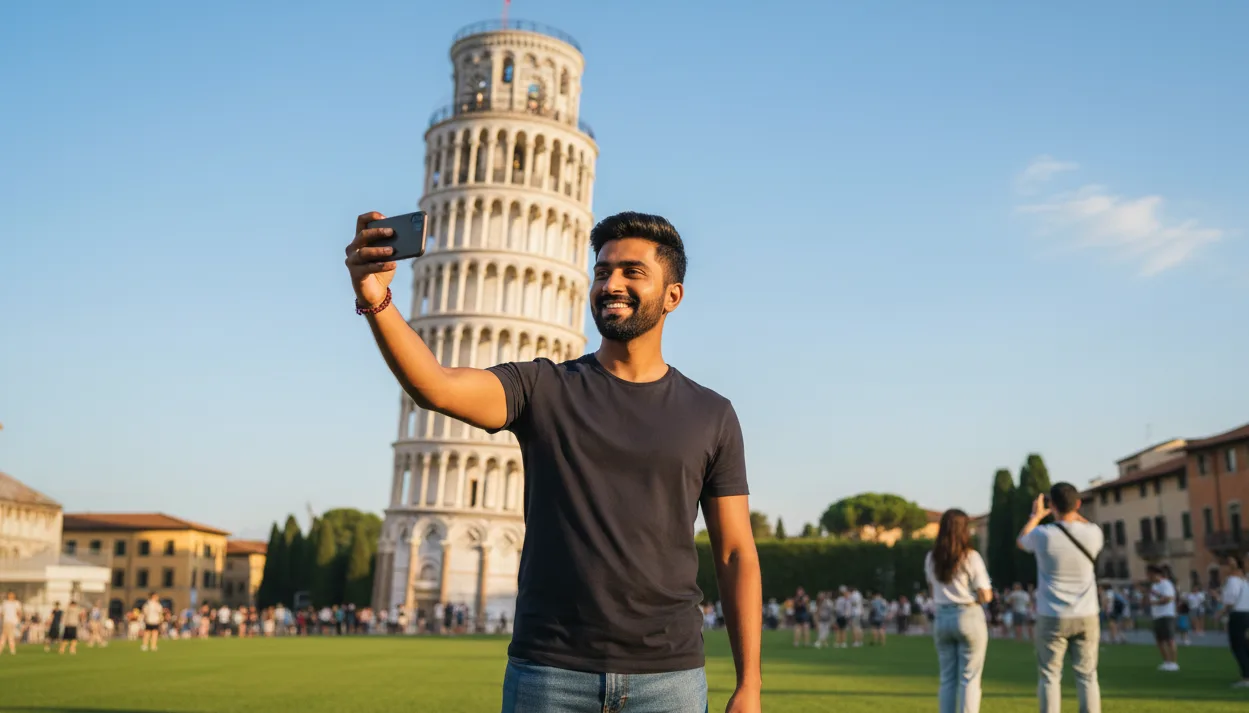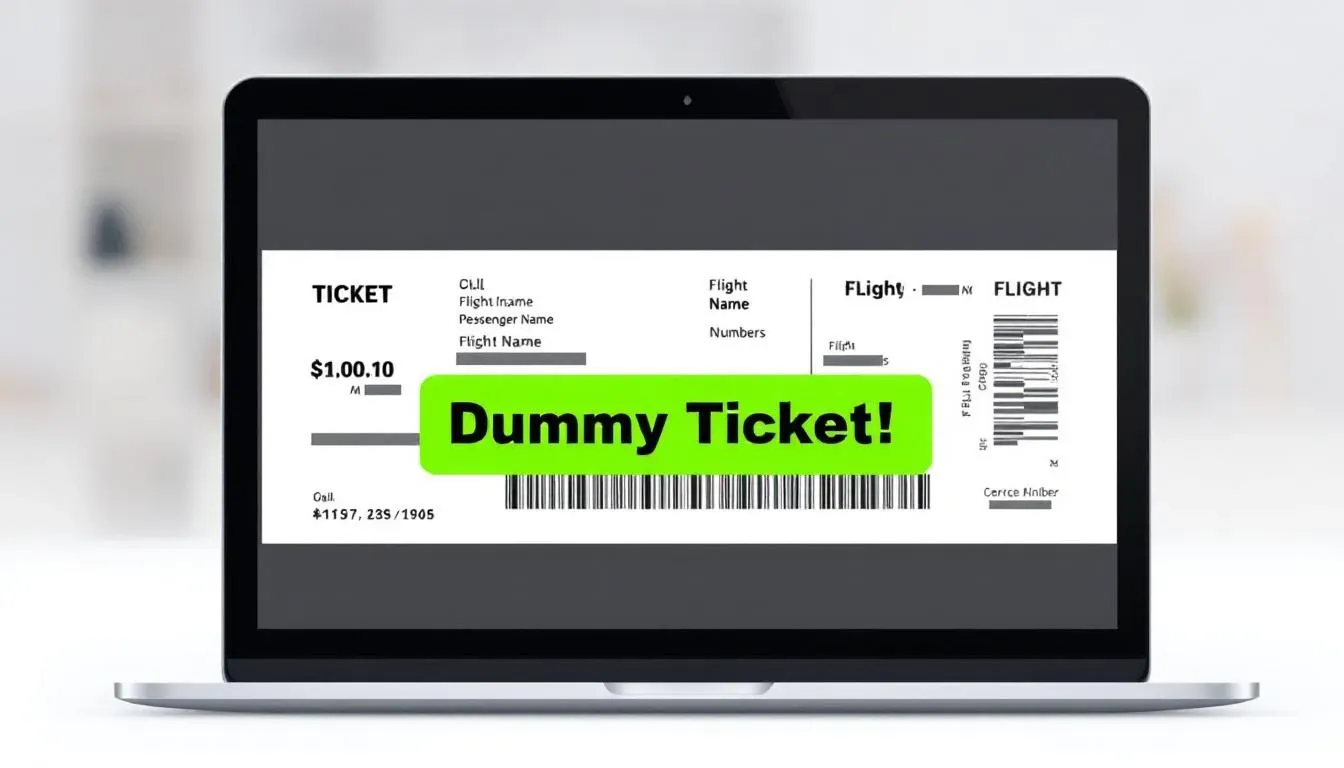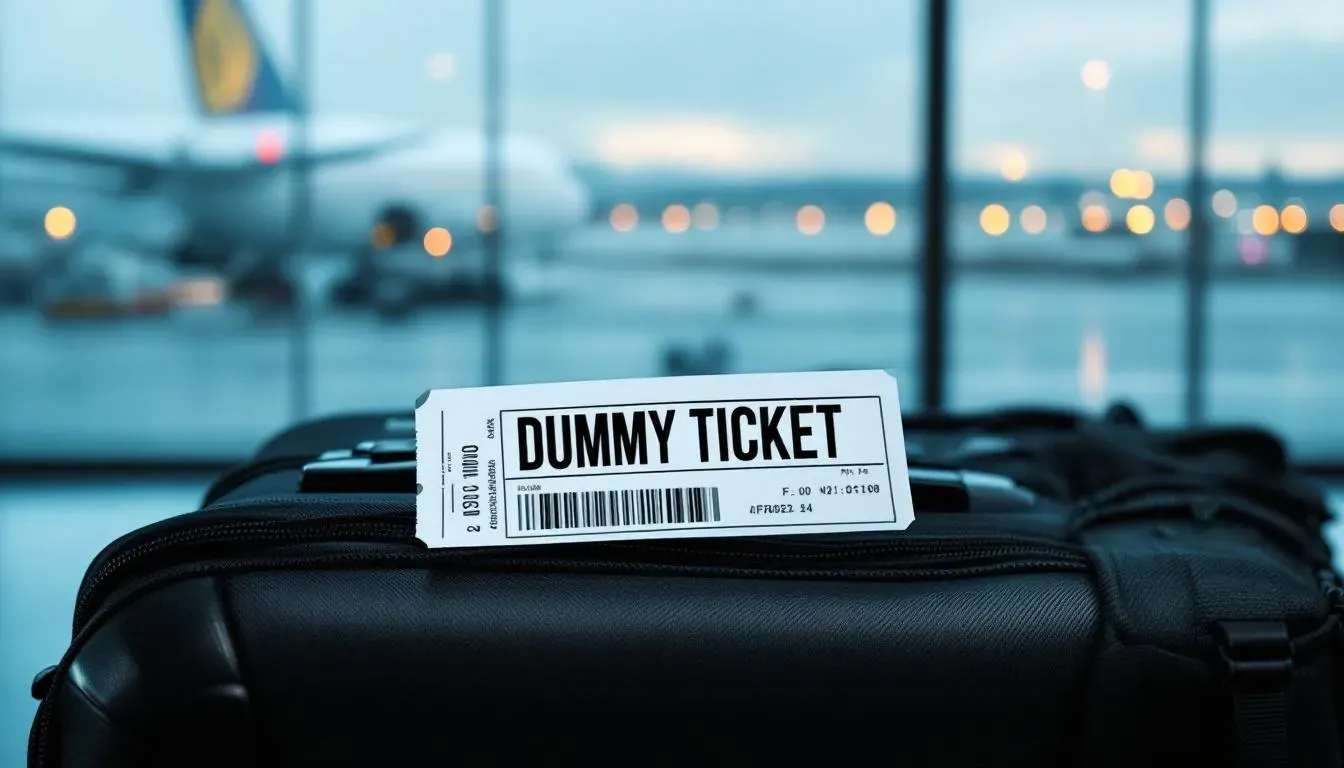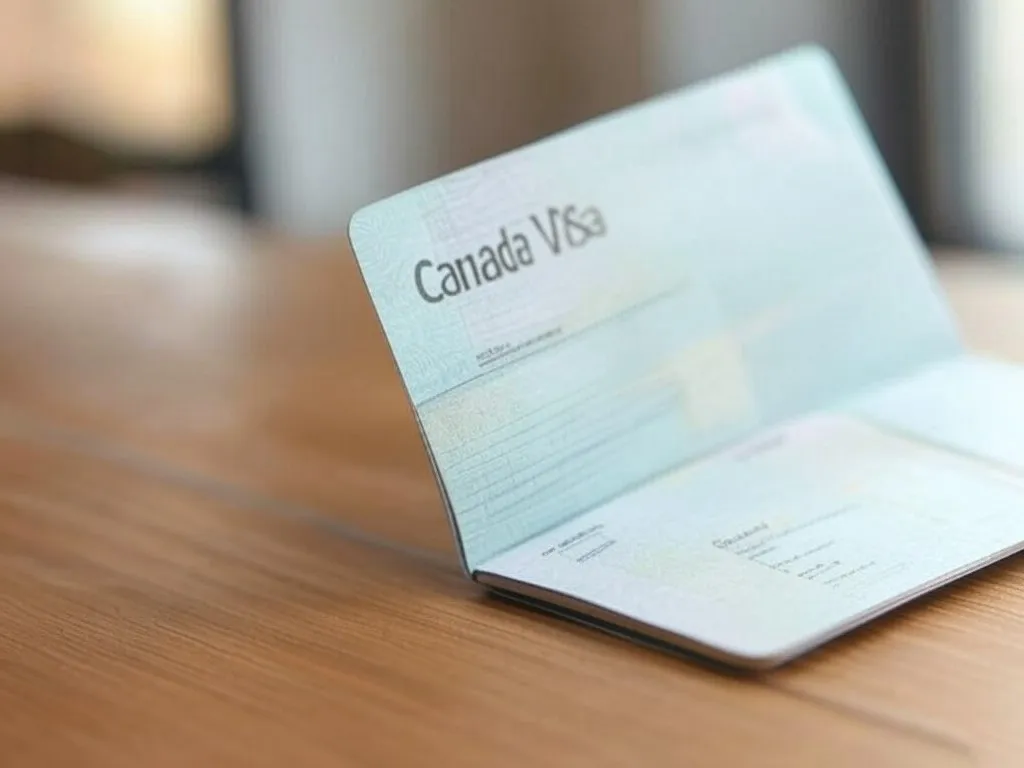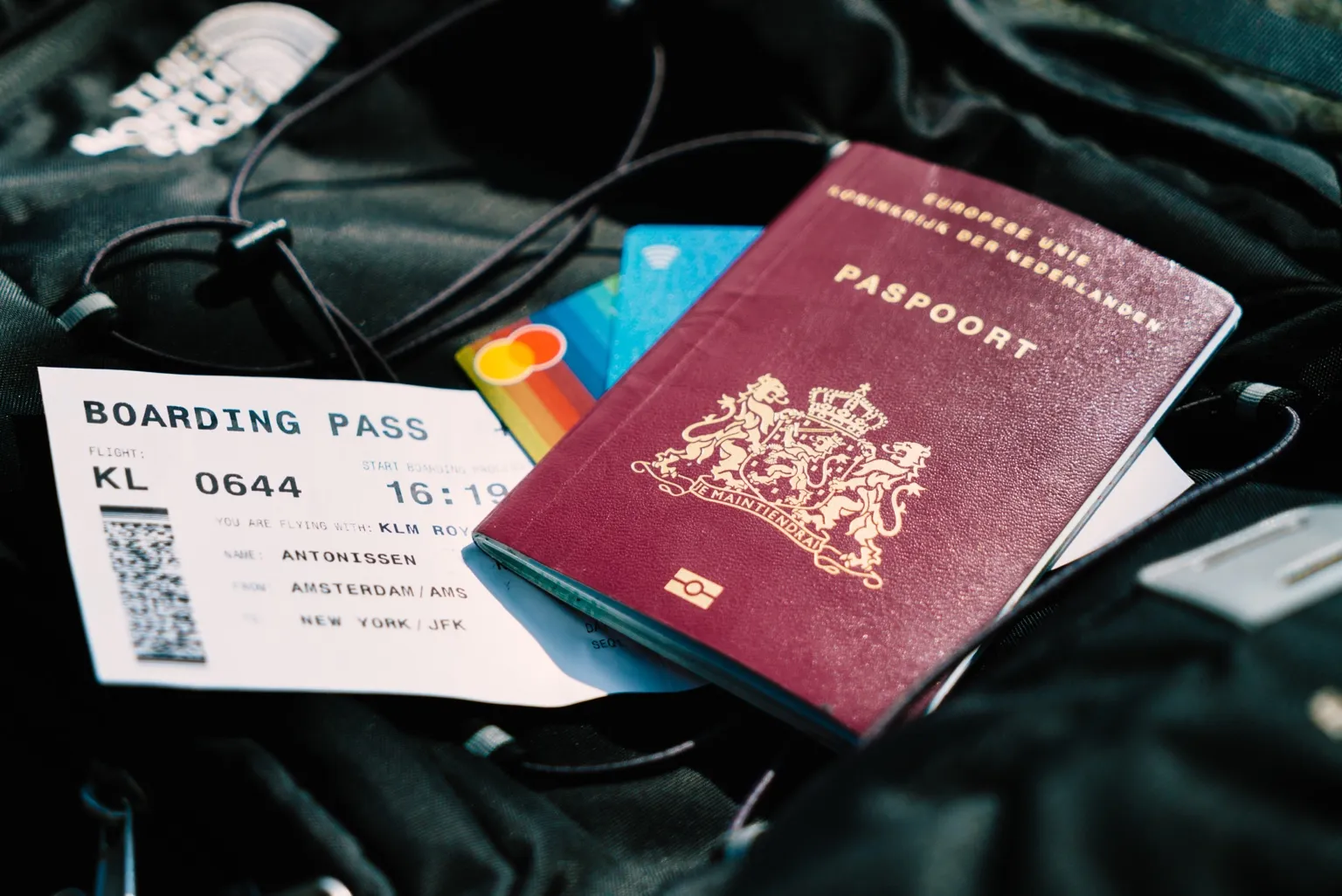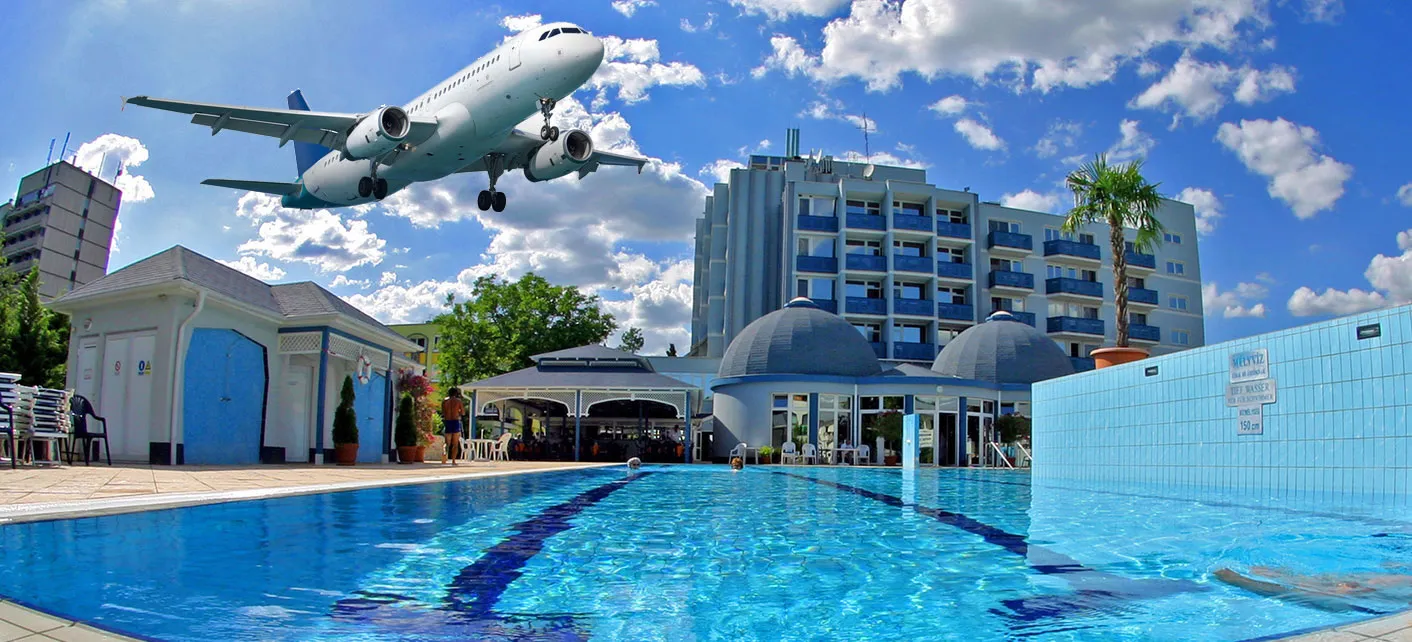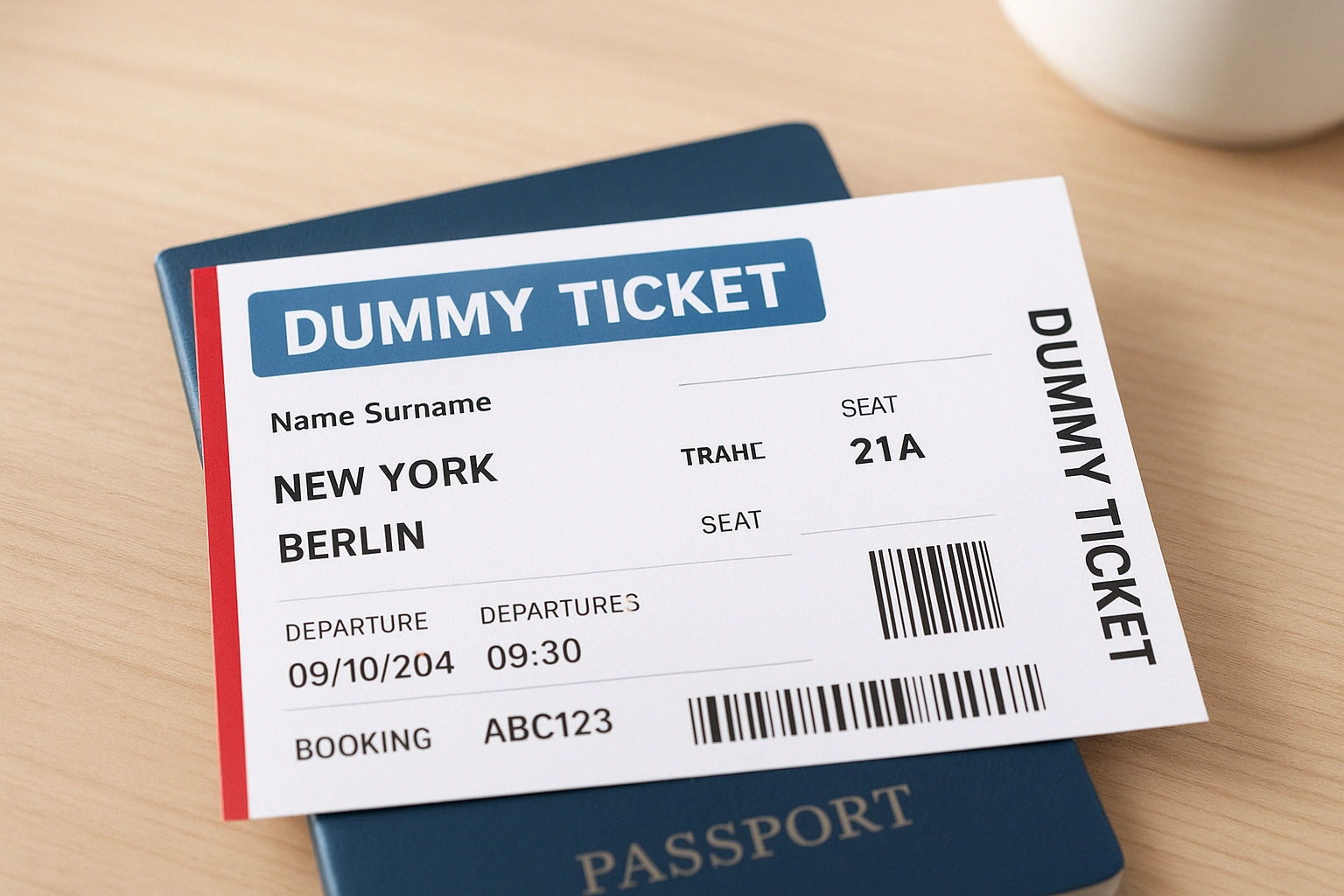Is Flight Itinerary Required For Italy Tourist Visa Application From India?
Your Italy plans feel real the moment you map your flights. The consulate thinks so, too. When you apply in India, they want to see how you intend to enter and exit Schengen, not a costly ticket you cannot change. That detail trips many applicants. You can avoid it. We’ll show you how to present a clean, believable round-trip plan that fits your hotels and insurance, so your file reads as one story. For more tips on preparing your application, check our FAQ.
You will learn what Italian consulates and VFS actually mean by “proof of intended travel,” which formats work, and when to update dates without causing delays. Whether you are a student watching budgets, a first timer, a family syncing calendars, or a digital nomad with flexible plans, this guide keeps your itinerary simple and solid. Secure your visa with a verifiable reservation—start your dummy ticket now. If you're new to this, explore our blogs for similar stories.
Yes — a flight itinerary for Italy tourist visa is one of the key documents required by Italian consulates when applying from India or any Schengen-bound country. Italian embassies do not ask you to buy a full ticket before approval, but they do expect a verifiable round-trip itinerary showing your entry and exit dates, which proves that you plan to return home after your trip. A real PNR flight reservation from BookForVisa.com satisfies this requirement safely and aligns perfectly with the Schengen visa checklist used for Rome, Milan, Florence, Naples, and Venice applications.
Last updated: November 2025 — verified against the official Italy Schengen Visa & VFS Global documentation guidelines.
Planning your trip? Learn more about our team's experience on the About Us page.
What “Proof Of Intended Travel” Really Means For India-Based Applicants
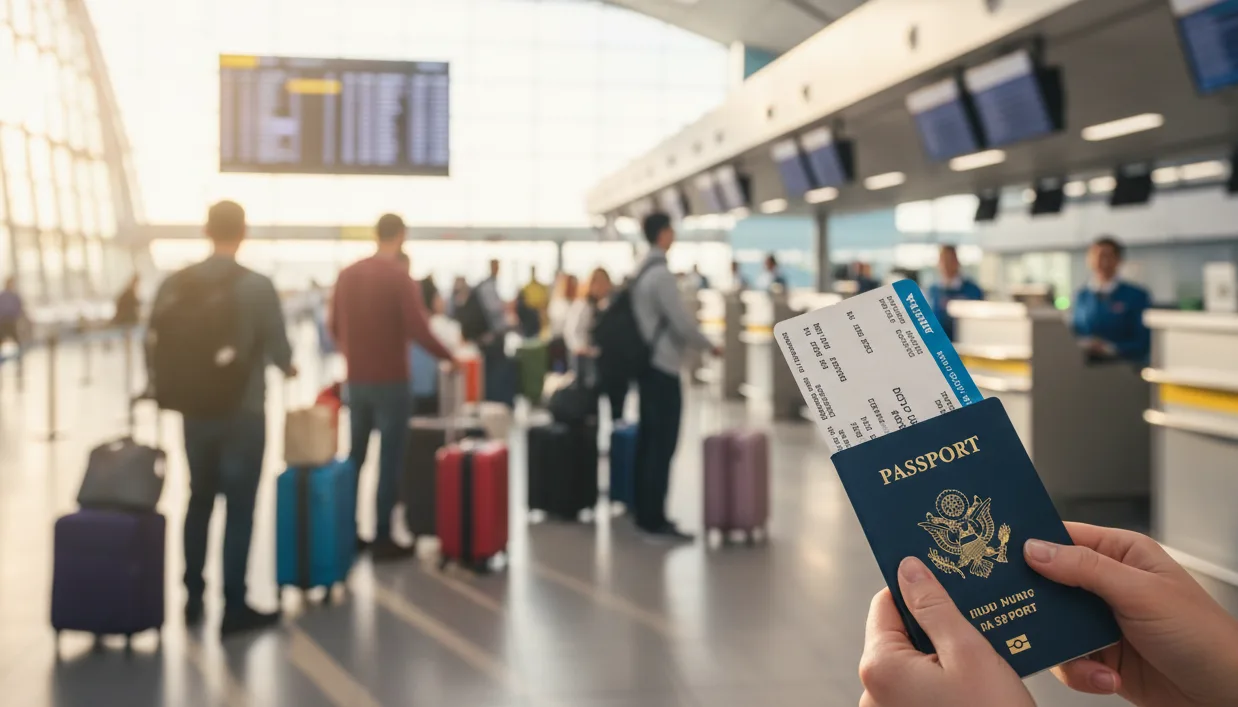
You do not need to gamble on a fully paid ticket to apply. Italian consulates want to see a sensible plan that matches the rest of your file. Think of it as your story in flight form. Dates, routes, and city choices should line up with hotels and insurance. When that happens, officers spend less time guessing and more time deciding. Tight deadline? Book a dummy ticket in minutes and keep your dates flexible.
How Italian Checklists Phrase It In Plain English
You will see phrases like proof of intended travel, round-trip flight reservation, itinerary showing entry and exit, or booking with PNR. The intent is the same. They want your proposed inbound and outbound flights in a readable format that displays passenger names, city pairs, dates, and a verifiable record locator. The word reservation appears more often than purchased ticket for a reason. Consulates know plans evolve during visa processing. They need the outline, not the final purchase.
If you are applying through VFS Global in Delhi, Mumbai, Bengaluru, Hyderabad, Chennai, or other centers, the staff checks that your papers match the checklist. They do not judge where you bought a reservation. They check that it exists, that it is legible, and that it makes sense with everything else you submit. For detailed Schengen rules, see Schengen Visa Info.
Why The Officer Cares About Your Proposed Flights
A flight plan answers three quick questions.
-
When do you arrive and depart the Schengen Area
-
Where do you first cross the Schengen border
-
Does the timeline fit the short stay rules and your accommodation plan
Your itinerary lets the officer confirm that your first hotel city aligns with your arrival airport. It shows that your insurance covers the entire stay. It shows that your exit is clear. If your return is from a different city, the hotels and intra-Schengen travel should reflect that. A tidy flight plan avoids back-and-forth emails for clarifications.
Reservation, Refundable Ticket, Or Paid Non-Refundable
For the application stage, most Indian applicants choose one of three formats. All can work if they are clear and consistent.
-
Temporary reservation with a verifiable PNR. Low risk and easy to update if the appointment shifts.
-
Refundable or flexible ticket. Higher cost but useful if your travel is fixed and you prefer to lock in flights.
-
Paid for a non-refundable ticket. Not required in most cases at this stage. Only consider if you are certain about travel and pricing.
What matters is checkability. Screenshots that cannot be validated in an airline or GDS system create doubt. Officers do not need you to prepay. They need to trust what they see.
India-Specific Realities You Should Plan Around
Appointments move. That is the Indian reality during peak seasons. Your reservation should survive a reschedule or be easy to refresh. Domestic connectors are fine. If you start in Ahmedabad or Pune and connect via Delhi or Mumbai, the important leg is your first Schengen entry. Make sure that the leg matches your hotel plan. Insurance from an Indian provider should start when you depart India and last through your return. Overcoverage by a day is safer than undercoverage.
If your route passes through non-Schengen hubs like Doha or Dubai, list the transit clearly. No hidden overnight stops. If you connect in London, verify separate transit rules before you pay later. For the application, clarity beats ambition. Keep the story simple and believable.
What A Strong Itinerary Looks Like On Paper
A strong itinerary is easy to read at a glance.
-
Passenger names match passports without spelling errors
-
PNR is visible and active during submission
-
City pairs follow your hotel flow. For example, Delhi to Milan, then Venice to Delhi if your hotels run from Milan to Florence to Venice
-
Dates align with your day-by-day plan and insurance period
-
Return city makes sense with your last hotel night
You can help the officer by preparing a one-page cover note that lists inbound date and airport, internal city sequence, and outbound date and airport. Keep the reservation PDF separate and unedited. If you highlight dates on a printout for your own reading, keep the digital file clean.
Clear Examples For First-Timers And Busy Families
Clear example. Bengaluru to Rome on 10 June. Rome to Delhi on 22 June. Hotels for Rome, Florence, and Venice in that order. Insurance from 9 June to 23 June. The story reads in one go.
Confusing example. Mumbai to Paris to Rome on entry. Zurich to Mumbai on exit. Hotels only in Italy. Insurance starts two days after arrival. This file invites questions. Either add hotels that match the Paris or Zurich elements, or keep the route inside Italy for the first application.
For families, sync everyone. Same entry date, same first entry country, same exit date. If one member travels later, explain that in a sentence. For students, affordability matters. Use a reservation that can be refreshed if your appointment slides. For digital nomads, keep the anchor dates clean even if your work location is flexible.
When And How To Update Without Derailing Your File
Plans change. If your VFS appointment shifts or your trip dates move by several days, refresh the reservation before submission. If you have already submitted and the dates change materially, email an updated itinerary and a short note with your application number. If your first entry country changes, always update. Small time-of-day changes rarely matter unless they alter hotel check-in dates or insurance coverage.
Think of updates as housekeeping. You are keeping the story aligned so the officer can decide without hesitation. When your documents speak the same language, your application feels complete.
Choose The Right Flight Proof For Your Case, Not The Most Expensive One

The consulate wants a plan that holds up, not a ticket that locks you in. Your job is to match the format of proof to your timeline, budget, and risk tolerance. Do this well, and you keep control of costs while giving the officer exactly what they need. Make your file scan-ready today with a quick dummy ticket booking.
Temporary, Verifiable Reservations: The Smart Default For Most Applicants
For most India-based files, a time-bound reservation with a checkable PNR does the job. You keep flexibility, you avoid big outlays, and you can refresh if the appointment slides.
Here is when this option shines:
-
Your VFS slot is one to three weeks away.
-
You expect possible rescheduling during peak season.
-
Your hotels are still moving, and you want your flights to follow.
What to watch:
-
Confirm the reservation is visible in an airline or GDS system.
-
Keep the passenger names passport-perfect.
-
Note the hold expiry and set a reminder to refresh a few days before submission.
This approach works especially well for students and first-time travelers who need to show intent without risking non-refundable fares.
Refundable Or Flexible Tickets: Pay More Only If It Buys Certainty
Sometimes you want a fully ticketed record because your travel is fixed or very near. A refundable or changeable fare can make sense when:
-
Your appointment is in a few days, and you want the ticket to stay live beyondthe decision.
-
You must travel on specific dates for an exam, conference, or family event.
-
You value the ticket’s after-approval convenience more than the fare premium.
Checklist before you buy:
-
Read the exact change and refund rules. Some “flex” fares still levy fees.
-
Check the refund timelines for your card.
-
Verify that any stop at a non-Schengen hub will not trigger a transit visa after you pay for companions later.
Use this path if you are deadline-driven and comfortable tying up funds temporarily. Families often prefer this close to travel, especially during school breaks.
Paid Non-Refundable Tickets: Rarely Needed At The Application Stage
You do not score extra points for paying early. Non-refundable tickets are a risk if your dates or entry point change. Consider them only when:
-
You already hold an approved visa or a near-certain multi-entry.
-
You are grabbing a genuine fare sale for fixed dates and can absorb change costs.
If you are still in the application phase, the safer play is a verifiable reservation or a refundable fare. The officer evaluates coherence, not spending.
“Dummy” Or Held Bookings: Make Them Real Enough To Trust
Held bookings can be fine if they are verifiable and readable. Weak screenshots do not help. Strong proofs share three traits:
-
They show a live PNR and flight segments that match your hotels.
-
They list full names and the India–Schengen legs clearly.
-
They remain valid through your submission date or can be refreshed quickly.
For digital nomads, this is a great bridge while you finalize coworking and apartment options. For students, it protects budgets while university dates shift.
Choose Like A Pro: Simple Decision Paths For Common Situations
You can decide in one minute with these quick guides.
Students:
-
Appointment is more than 10 days away. Use a verifiable reservation, refresh near submission.
-
Appointment is within 3–5 days. Reservation still works. Keep a backup plan to refresh post-submission if asked.
First-time applicants:
-
Keep routing simple. Prefer India to Italy direct or via one hub.
-
If your first hotel is in Rome, arrive in Rome or show the connecting leg to Rome the same day.
Families:
-
Everyone on the same flights, if possible.
-
If grandparents depart a day earlier, add a one-line cover note to explain.
-
Avoid split airlines that make the story hard to follow unless there is a clear reason.
Digital nomads:
-
Use an anchor round trip that frames your Schengen stay.
-
Plan open-jaw only if hotels support the flow. Rome in, Milan out is fine when your city sequence matches.
Keep The Officer’s View In Mind: What They Check First
Officers read fast. Make the essentials pop.
-
Entry date and first Schengen airport.
-
Exit date and last Schengen airport.
-
Night count by country if you touch more than one.
-
An insurance period that covers the entire stay.
-
Hotels that align with the city sequence and flight endpoints.
Present your file cleanly:
-
Name your PDFs clearly and keep each document unedited.
-
Add a short cover note summarizing the route.
-
Place flights first, then hotels, then insurance, so the story reads in order.
Keep Validity Alive: Refresh Without Creating Confusion
Reservations expire. You can refresh without derailing your file if you manage versions.
-
Refresh two to five days before submission if the hold will lapse.
-
If your appointment moves, refresh again and keep only the latest version in your folder.
-
After submission, update only when dates shift by several days, entry country changes, or your return city changes. Attach a short note with your application number.
A clean update is better than letting a PNR lapse. It shows you are organized and keeps the decision moving.
India-Specific Watchouts That Save Time
-
Domestic connectors are fine. Prioritize clarity on the first Schengen leg.
-
If you route through London, research separate transit rules before buying any paid ticket after approval.
-
Overcover insurance by at least one day on both ends. Undercoverage is a common reason for queries.
-
Keep family files identical where possible. Officers do not enjoy reconciling five different routings for one group.
Pick the proof that fits your reality today. Keep it verifiable, consistent, and current. That is the formula that works for India-based applicants applying for an Italy tourist visa.
👉 Order your dummy ticket today to match your itinerary perfectly.
Avoid Date Drama: Risks, Updates, And Consulate-Smart Habits
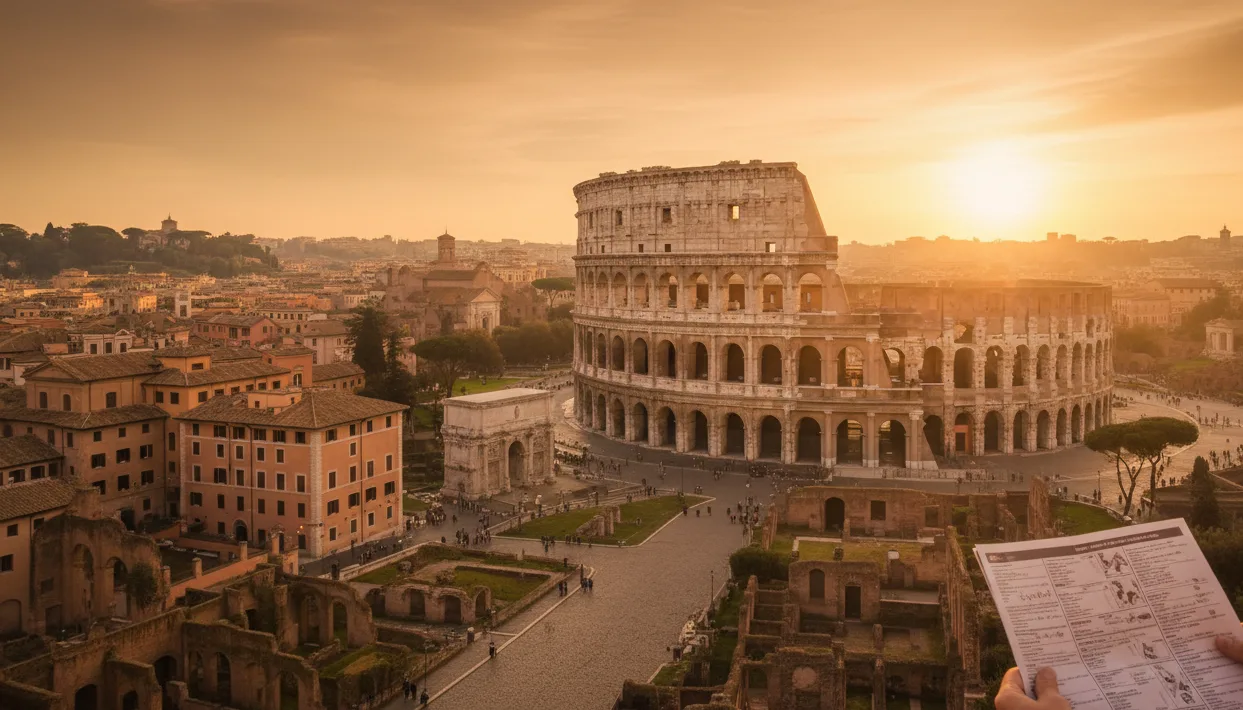
Even a solid flight plan can wobble if the rest of your file tells a different story. Keep the moving parts in sync, and you remove the biggest reasons for delays, calls, and document requests. If your appointment has moved, simply book a dummy ticket and update your PNR.
Spot The Tripwires Before They Trip You
Most hiccups start with small mismatches. Your flights say one thing, your hotels say another, and your insurance does not cover the full stay. That is where otherwise clean visa application files slow down. For Indian passport holders, the fix is simple: line up dates, cities, and coverages before you print.
Common red flags:
-
Your first hotel city does not match the airport of arrival when entering Italy.
-
Insurance ends a day early, or does not clearly span 90 days from your start date, for flexibility.
-
You claim multiple entries, but your plan shows a single round trip.
-
You reference a previous Schengen visa, yet your dates suggest a longer stay than allowed for a Schengen short-stay visa.
If a section of your case feels off, assume the officer will notice. Adjust the plan or add a short note that explains the logic.
Keep Dates Aligned When Life Changes Your Plans
Appointments shift, sales come and go, and relatives confirm late. When your travel date moves, make three quick checks:
-
Refresh the flight reservation so the PNR is live at submission.
-
Extend travel insurance to match the new return.
-
Update hotels or add a cover note if you are waiting on confirmations.
If you have already submitted a visa application centre and the dates have changed by several days, send an updated itinerary and revised insurance. Include your file number and keep the message brief. That shows control, not confusion.
Match Proofs To Your Visa Story
Your itinerary should echo the rest of the file. If you plan to visit Italy for tourism, keep routing simple and nights in Italy. If you are heading to other countries in the region, make sure Italy is still the main destination or the first entry, and that the night count across Schengen countries makes sense. For short trips tied to business meetings, a brief cover letter and company schedule help the officer see why your dates are tight.
Students often juggle shifting university calendars. If you hold a student visa or are switching to a study visa, keep the tourist routing realistic and non-overlapping with term dates. Families visiting relatives can attach an invitation letter that fits the cities on the flight plan. When your purpose is clear, the chosen visa type lines up naturally.
Documents That Whisper “Organised” To The Officer
Before your Italy visa appointment, run a last-mile checklist so your package feels complete:
-
Names on flights match passport spelling and passport details exactly.
-
The reservation shows readable segments and PNR.
-
Hotels follow the city sequence implied by the flights.
-
Insurance starts the day you depart and ends after you return.
Add a one-page summary with your inbound airport, outbound airport, and total nights. Place the required documents in an intuitive order so the application process reads like a story. If the consulate asks for additional documents, send only what is relevant and keep file names clear.
What To Do If You Have A Travel History Or None At All
A strong history helps, but it is not mandatory. If you held a valid Schengen visa in the past, make sure your new plan respects previous stay limits. If you have previous passports, check that the personal data matches your current original passport. If you are new to Europe, compensate with clarity: tidy routing, realistic dates, and proof of sufficient financial means through bank statements or other financial documents.
Timelines: Move Early, Buffer Wisely
Build slack into your schedule. During peak travel seasons, slots can be scarce and response times stretch. Factor in the typical Italy visa processing time and the broader processing time guidance for your city. Filing early also helps with cost control, since you can refresh reservations without buying non-refundable tickets. If you must apply for a visa on a tight calendar, keep your plan minimal and consistent.
Forms, Fees, And Small Choices That Reduce Friction
Neat paperwork is underrated. Fill the visa application form or application form carefully, double-check dates, and make sure your contact data matches what appears on flight and hotel receipts. Pay the visa fees using the method your Italian embassy or VAC prefers, and keep the receipt handy. If you use VFS value-added services, such as the premium lounge facility, treat them as comfort choices; they do not change decisions but can make the day easier.
If you are applying online for appointment scheduling or tracking, keep screenshots of confirmations. On the day, carry copies of the following documents: flights, hotels, insurance, and ID. Some centres offer a courier facility or courier assurance facility; use it if travel to pick up results is inconvenient.
When Your Purpose Isn’t Pure Tourism
Tourism rules cover most readers, but plans differ. An Italian business visa needs schedules on company letterhead and routing that fits business purposes. Family visits benefit from ties proof and a sensible stay length. If your situation is visa-based on long stays, or you plan a long-term visa, your flight plan and necessary documents will differ and may vary depending on the category. Always read the Italian Ministry guidance for your stream.
India-Based Travelers
Your itinerary is a map, not a trap. Choose simple routing, keep proofs consistent, and respect limits for a Schengen visa. For many indian nationals, that calm, coherent plan is all it takes to secure a valid visa for a straightforward Italy visa application and a smooth visa appointment. When your documents sing the same tune, officers can decide quickly—and you can plan the fun parts of the trip.
Beat The Clock: Timing, Validity, And Zero-Drama Updates
Good timing smooths everything. Plan your flight with the appointment in mind, not the final ticket. A few smart habits keep your file current without extra spending or stress. Save money before approval—choose a low-risk dummy ticket booking.
Work Backward From Your Appointment Date
Start with the day you submit to VFS or the consulate. That is your anchor. Now plan in reverse.
-
Four to six weeks out: lock your hotels for the main cities. You can still tweak nights, but set the overall shape.
-
Two weeks out: secure a verifiable flight reservation that matches the hotel flow. This usually keeps the PNR alive through submission.
-
Three to five days out: check the hold expiry. Refresh the reservation if it will lapse before or on your appointment day.
-
Submission day: carry a print and keep the PDF handy. Ensure the PNR is still live.
This timeline keeps flexibility high and surprises low. It also avoids paying for non-refundable tickets before you need to.
How Long Hold Usually Last, And What To Do About It
Holds are not all equal. Some airline or GDS reservations live only a couple of days. Others survive a week or longer. Treat validity like milk in the fridge. Check the date and replace it before it spoils.
Simple rules:
-
If the reservation expires before submission, refresh it.
-
If the decision may take time, be ready to refresh again only if the consulate asks for an updated itinerary.
-
Avoid stacking multiple different routings. Keep one clear version active.
The goal is a single, believable plan that remains current through the points where officers look at it.
What If Your Appointment Moves
Reschedules happen. Do three quick fixes, and you are fine.
-
Generate a fresh reservation that spans the new submission date.
-
Push your insurance coverage to the new return if needed.
-
Adjust hotel nights or add a one-line note explaining any gap you are still finalizing.
Send updates only if your file has already been submitted and the change is material. That means several days’ shift, a different first entry country, or a new return city. Small time-of-day tweaks do not usually need a notification.
After You Submit: Keep It Current, Not Complicated
You do not need to maintain a live reservation every single day after submission. Stay practical.
-
If the consulate requests an updated itinerary, refresh and send the new PDF with a short reference to your application number.
-
If your trip dates move by more than a couple of days while the decision is pending, consider sending a clean update so the record matches reality.
-
Do not send multiple versions in quick succession. Every update should simplify the story, not multiply it.
Think of yourself as the editor. Fewer, cleaner pages win.
Make Your Package Readable In Seconds
Officers scan first, then read. Help them scan well.
-
Use short file names that say exactly what the document is. Example: Flights_Name_PNR.pdf.
-
Put flights first, then hotels, then insurance. The sequence tells the story.
-
Add a one-page cover note with the entry airport and date, the exit airport and date, and the city order.
-
Keep the reservation PDF unedited. If you need to emphasise dates, do it in the cover note.
This saves review time and reduces the chance of a call or email asking for clarifications.
Families And Groups: Synchronise Once, Not Thrice
Group files get messy fast if you let them. Keep one route for everyone where possible, even if seat assignments differ.
-
Same entry date and airport.
-
Same exit date and airport.
-
If one person travels on different days, explain in one sentence and attach that one person’s variant.
Bundle shared documents together with a simple index. The less page shuffling, the better the experience for everyone.
First-Timers And Students: Build Slack Into Your Plan
If you are new to Schengen travel or juggling exam schedules, give yourself room to move.
-
Choose an entry city that matches your first hotel night.
-
Avoid routing with too many connections. One clean hub is enough.
-
Keep the return flexible until the visa is approved.
-
If a date shifts, refresh the reservation first, then align hotels and insurance.
This sequence keeps your costs down and your file coherent.
Practical Traps To Avoid
A few avoidable mistakes cause most of the delays.
-
Submitting with a PNR that has already expired. Always check the timestamp the day before.
-
Mismatched hotel sequence. Your return flight leaves from a city you have never stayed in.
-
Insurance that starts after you depart or ends before you return. Overcover by a day on each side.
-
Multiple conflicting itineraries in the same file. Choose one and retire the rest.
Treat every document like a chorus member. They should all sing the same tune.
BookForVisa.com Makes Your Life Easier
If you want a verifiable reservation, you can refresh without repurchasing tickets; you can use BookForVisa.com. We issue visa-grade flight reservations with a live, checkable PNR for ₹1,300 per reservation, delivered instantly, and with unlimited date changes. It is useful when appointments shift or when you want officers to verify records quickly. Use it only if it fits your situation.
After Approval: Buying The Real Ticket Without Surprises
Once your visa arrives, buy the actual ticket that matches your plan. Before you pay, do two final checks.
-
Transit rules for any non-Schengen hub on your route. London, for example, has separate requirements.
-
Baggage and change policies that match your comfort level. A low upfront fare can be costly to modify later.
If prices have moved since you first planned, keep your routing logic but explore nearby dates. A one-day shift often saves money without changing the story you already told.
Time, validity, and tidy updates are the quiet heroes of a smooth application. Keep your plan realistic, your PNR alive when it matters, and your documents in sync. Do that, and your itinerary will do exactly what it should: make approval easier.
Your Itinerary, Simplified And Approved Italy Visa Application
When you start the visa application process, you don’t need a paid ticket to build a strong case for a visa for Italy. What you do need is a clear flight plan that matches your hotels, insurance, and other documents required, and that stays up to date through submission. Keep Italy as the anchor among the Schengen states, show sensible entry and exit points across nearby EU countries, and refresh your reservations when dates shift. Whether you’re applying for an Italian business visa, visiting family, or traveling for non-business-related purposes, the core strategy remains the same.
Please note that choosing one coherent route, naming your files clearly, and adding a short cover note helps an officer scan and understand everything in seconds. If an officer asks for additional documentation later, a tidy, consistent itinerary will still support your case. After approval, buy the real ticket that mirrors your plan so you can travel freely.
Stay organized, keep your proofs verifiable, and let your itinerary do its job—then you can focus on the fun parts of the trip. Ready to finalize your documents? Book a dummy ticket and submit with confidence. Ready to finalize your documents? Book a dummy ticket and submit with confidence.
What Travelers Are Saying
Related Guides
Why Travelers Trust BookForVisa.com
BookForVisa.com has been helping travelers since 2019, supporting over 50,000 visa applicants with specialized dummy ticket reservations. Our niche expertise in verifiable flight proofs ensures seamless applications for destinations like Italy. We offer 24/7 customer support from a dedicated team, secure online payments, and instant PDF delivery. As a registered business, BookForVisa.com provides real, non-automated assistance to make your process stress-free and reliable.
Frequently Asked Questions About Flight Itineraries for Italy Visa
To further assist, here are some common questions expanded for clarity:
What exactly is a dummy ticket, and is it legal for Italy visa applications?
A dummy ticket is a temporary, verifiable flight reservation with a real PNR that you can use as proof of intended travel. It's fully legal as long as it's not misrepresented as a paid ticket. Italian consulates accept them because they show intent without requiring full payment upfront. Always ensure it's from a reputable source like DummyFlights.com to avoid verification issues. This approach saves you from non-refundable bookings while keeping your application strong.
How soon before my appointment should I get a dummy ticket?
Ideally, 1-2 weeks before your VFS slot, but you can get one as early as needed and refresh it closer to submission. Holds typically last 24-72 hours, so plan reminders. For peak seasons in India, starting early prevents last-minute stress. If your dates change, unlimited revisions on platforms like DummyFlights.com make updates effortless, ensuring your PNR stays live.
Can I use a dummy ticket for a family group application?
Yes, absolutely—one dummy ticket can cover the whole family if names match passports. Sync all details: same entry/exit points and dates. This simplifies officer review and avoids mismatches. For mixed schedules (e.g., kids arriving later), add a cover note. Families report 90% faster processing with coordinated proofs, making group travel to Italy smoother.
What if my dummy ticket expires before visa approval?
Refresh it immediately—most services allow instant reissues. Submit the updated PDF with your application number via email to VFS. Consulates appreciate proactive updates, as it shows organization. Avoid letting it lapse, as unverified proofs can delay decisions by weeks. With flexible options, this is a minor step that keeps your Italy dreams on track.

